Herbig-Haro 49 & 50, first noted by Schwartz ( see
W. J. Zealey et al. 1998 )
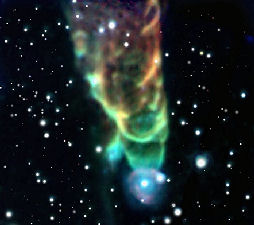
One of the more recent and dramatic images of HH objects appeared on the APOD website on August 11, 2007 and it gives an insight into the turbulent forces within these objects. "Light-years in length, this cosmic tornado is actually a powerful jet cataloged as HH (Herbig-Haro) 49/50 blasting down from the top of a Spitzer Space Telescope view. Though such energetic outflows are well known to be associated with the formation of young stars, the exact cause of the spiraling structures apparent in this case is still mysterious. The embryonic star responsible for the 100-kilometer per second jet is located just off the top of the picture, while the bright star seen near the tip of the jet may just by chance lie along the line of sight. In the false-color infrared image, the tornado glows with infrared light generated as the outflow heats surrounding dust clouds. The color coding shows a trend from red to blue hues at the tornado's tip indicating a systematic increase in emission at shorter wavelengths. The trend is thought to indicate an increase in molecular excitation closer to where the head of the jet is impacting interstellar gas. HH49/50 is about 450 light-years distant, located in the Chamaeleon I molecular cloud." Credit: J. Bally (Univ. of Colorado) et al., JPL-Caltech, NASA, image from
APOD
But it seems that the more we discover about these objects, the less we seem to know. In commenting on HH49/50's shape and apparent composition Giovanni Fazio, a physicist at the Harvard-Smithsonian Center for Astrophysics said, "I've never seen anything quite like this one...We were really quite stunned by it," and in a news article about HH49/50
msnbc.com's Technology & Space website noted that:
"Scientists aren't sure what is behind HH 49/50's unique spiral shape. One hypothesis is that magnetic fields in the region are somehow twisting the particle jets; another idea is that the shock waves are creating eddies in the dust clouds which then glow and become visible."
In their 2006 article
A "Tornado" in Space the
thunderbolts.info website also noted this, adding "In fact, astronomers express great astonishment at such formations. Gravitational models featured in twentieth century astronomy never envisioned narrow jets of anything streaming away from stellar bodies. Neither gravity nor standard gas laws would allow it." These are not the only sources pointing to some very big unknowns in regard to Herbig-Haro objects:
On the topic of jets and outflows, the last of these papers ( René Liseau et el. ) noted that "[s]ince their discovery nearly three decades ago, the unexpected phenomenon of outflows in star forming regions has remained essentially unexplained. In particular, the processes responsible for the acceleration and collimation of the flows present one of the major unsolved problems of modern astrophysics". However, the researchers were able to state that with recent observational results now in hand, detailed comparison with theoretical models could be had. While HH 49, 50 and 111 have all seen intense study into the struture of their respective jets extending behind the shock front ( where, in the cooling gas, electrons and ions recombine to give an emission line spectrum that is characteristic of Herbig-Haro objects ), so too has HH34 and it's bipolar outflowing jets.
Herbig-Haro 34, first noted by Haro ( see
Reipurth et el. 2001 )
One of the interesting characteristics of HH34 ( and of many others for that matter ) is in the deceleration of the shocks within the bipolar jet's outflow. In
Dal Pino, 2000 it was noted,
"The deceleration occurs as momentum is transferred by gas expelled sideways from the traveling pulses. The simulation of a pressure-confined, steady state jet with similar initial conditions to those of the pulsed jet shows that the flow in this case experiences acceleration. This result is thus an additional indication that the primary source of deceleration in the giant flows cannot be attributed to braking of the jet head against the external medium." In other words, the observed slowing within the jet is a mechanism within the jet itself rather than an external slowing due to collisions with the surrounding interstellar medium: "the symmetric pattern of deceleration in both lobes of the jet indicates that the process is rather internal to the flow. Our three-dimensional simulations show, in fact, that deceleration can be naturally produced in jets formed by long-period, large-amplitude velocity variations, where momentum is progressively lost from the central axis and transferred sideways by the traveling pulses." This was one of the jet's unknowns — that radial velocity models did not account for certain observed deceleration within the jet itself. [13] Also see:
A. Riera et al. The high-velocity outflow in the proto-planetary nebula Hen 3-1475;
R. López et al. 3-D kinematics of the HH 110 jet
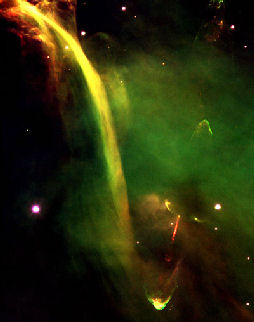
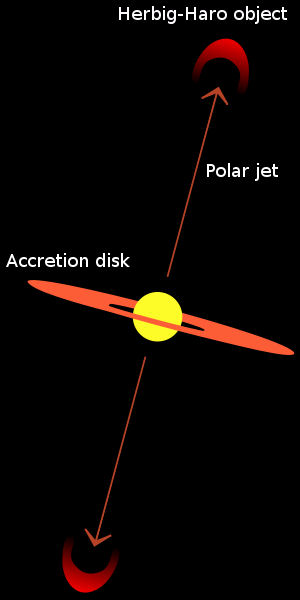
Two opposite jets ram into the surrounding interstellar matter forming HH34, another object with some very distinct characteristics and unknowns. "Some features of HH-34 are understood -- some are not. At the core of Herbig-Haro 34 lies a seemingly typical young star. This star, though, somehow ejects energetic "bullets" of high-energy particles, appearing as red streaks toward the lower right of the this image. Astronomers speculate that a burst of these particles might rebound when gas from a disk surrounding the star momentarily collapses onto the star. Visible near the end of each light-year long jet is a glowing cap. HH-34 lies about 1500 light-years away in the Orion Nebula star-forming region. The cause of the large arc of gas on the upper left known as the waterfall remains unexplained." Image from
APOD, credit: FORS Team, 8.2-meter VLT, ESO.
At right is a drawing created
by Gregory Maxwell, illustrating the basic mechanics of HH objects. The images shows material being ejected ( the jet ) by a nearby young star ( protostar ) and colliding at supersonic speeds with the interstellar medium ( ISM ). The resulting shock waves of fast moving and heated gases responsible for generating the visible light we observed as the HH object.
On the physics of Herbig Haro Shocks and "working surface", the
Jetset website explains,
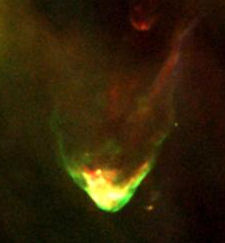
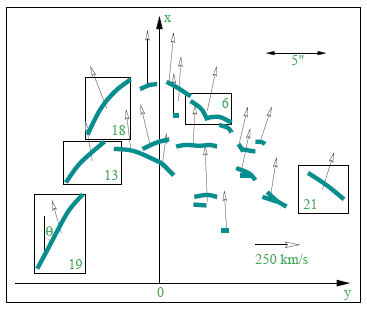
"As the collimated protostellar jet interacts with the undisturbed ambient medium, it generates what is known as a "working surface" that the observer then sees as an HH object. The most violent interaction occurs at the initial point of contact between the jet and the ambient medium resulting in a terminal working surface, which is often bow-shaped (for example HH 34S shown [left]). Internal working surfaces trace milder internal collisions within the outflow itself. Each HH object or knot represents a major event of mass ejection and it is therefore likely that these internal shocks occur when fast moving gas from a fresh ejection episode catches up with slower moving material ejected earlier. Hence the archetypal HH jet mentioned above is traced by a series of knots. This is the exact morphology of the HH 34 jet as imaged in [SII] [not shown]. Indeed several of the knots in this flow appear to be bow-shaped, consistent with the idea that they are internal working surfaces." The image at left is a close-up from the larger image, Protostar HH-34 in Orion from the
ESO website showing HH34S. The image on right is from a publication ( A. C. Raga et al., 2002 ) discussing the different approaches that have been used for modeling the emission of Herbig-Haro objects, in this case, Herbig-Haro34. The "[s]chematic diagram showing the filamentary structure observed in H

HST images of HH 34S and the proper motions derived by Reipurth et al. (2002). The x-axis approximately coincides with the outflow axis. We have chosen 5 of the cross-correlation boxes of Reipurth et al. (2002), which lie along the edge of the bowshock and which include filamentary structures with well defined orientations (the boxes are numbered 6, 13, 18, 19, and 21). [14]
Herbig-Haro 30 & XZ Tauri


At left is a six-year time-laspe movie created from images taken of HH30. Writes the
Hubblesite NewsCenter, "as in XZ Tauri, material is being ejected along the magnetic poles of the star at speeds of between 200,000 and 600,000 miles per hour (320,000 and 960,000 kilometers per hour). Every few months a compact clump of gas, called a knot, is ejected, and may eventually merge with other clumps downstream. However, astronomers aren't sure why the knots in the upper jet are moving only about half as fast as in the fainter, lower one." Credits: Alan Watson (Universidad Nacional Autonoma de Mexico, Mexico), Karl Stapelfeldt (NASA Jet Propulsion Laboratory), John Krist (STScI), and Chris Burrows (ESA/STScI)
Amongst a wealth of stellar objects within this region is also XZ Tauri, "a young system with two stars orbiting each other. The pair is separated by about 4 billion miles (6 billion kilometers), about the distance from the Sun to the planet Pluto in our own solar system. Hubble astronomers were surprised to discover a bubble of hot, glowing gas extending nearly 60 billion miles (96 billion kilometers) from this young star system. The bubble's temperature is over 17,500 degrees Fahrenheit (9,700 degrees Celsius). The bubble appears much broader than the narrow jets seen in other young stars, but it is caused by the same process - the ejection of gas from a star." The images show the dramatic change in the bubble's form between 1995 and 1998. Credits: John Krist (STScI), Karl Stapelfeldt (NASA Jet Propulsion Laboratory), Jeff Hester (Arizona State University), Chris Burrows (ESA/STScI)

At left is an image from the
Aladin previewer site showing the area around Herbig-Haro 30 and the XZ Tauri system. HH30 is located at RA 04 31 37.5 Dec +18 12 25 and is also known as V1213 Tau and 2MASS J04313747+1812244. The image is an RGB composite of several Palomar Observatory Sky Survey II plates in Red and Blue.

This particular region contains a wealth of other stellar objects within a 10 arcminute radius of HH30 that includes: Herbig-Haro objects 150, 151, 152, 153, 154, 265A, B & C, 454A, B & C, Lynds Dark Nebula LDN 1551, the variable stars Bad 17, 18 & 19 and the molecular cloud MBM 109 ( just off the lower right of image ), to mention just a few of the 252 objects returned from the SIMBAD data query site. [15] Image at right: "This Wide Field and Planetary Camera 2 (WFPC2) image shows Herbig-Haro 30 (HH 30) the prototype of a young star surrounded by a thin, dark disk and emitting powerful gaseous jets. The disk extends 40 billion miles from left to right in the image, dividing the nebula in two. The central star is hidden from direct view, but its light reflects off the upper and lower surfaces of the disk to produce the pair of reddish nebulae. The gas jets are shown in green." Credit: Chris Burrows (STScI), the WFPC2 Science Team and NASA, from the
ESA Science and Technology website.
Herbig-Haro Movies


One of the benefits of Herbig-Haro objects stems from their very fast jets and, in stellar terms, their relatively short life spans. Since 1995, several HH objects have had their complex structures and variable speeds well demonstrated in a series of movies composed of the still images taken over the intervening years. To the left is Herbig-Haro 1 and at right, the bow shock of Herbig-Haro 47.
These movies are from Patrick Hartigan's site,
Herbig-Haro Jet Movies from HST, where others on Herbig-Haro objects may be found.
Sources
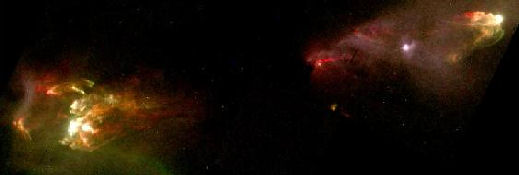
Image of Herbig-Haro 1 and 2 from the
APOD website "A cloud of interstellar gas and dust collapses and a star is born. At its core temperatures rise, a nuclear furnace ignites, and a rotating dusty disk forms surrounding the newborn star... [t]he bright blobs at either end are where the jet material has slammed into interstellar gas. Tip to tip, the distance is about one light-year."
Credit: J. Hester (ASU), WFPC2 Team, NASA
- "Burnham, Sherburne Wesley" 22 April 2009. HowStuffWorks.com 06 June 2009.
- "Sherburne Wesley Burnham" 30 April 2009. Wikipedia 06 June 2009.
- "Herbig—Haro object" Wikipedia 06 June 2009. Also see The Bruce Medalists - George Howard Herbig by Joseph S. Tenn 2008-01-25 and George Herbig from NNDB Tracker website, Copyright © 2009 Soylent Communications
- vv Puppis from Simbad, C.D.S.-SIMBAD4 rel 1.123-2009.06.11CEST23:43:08
- Osterbrock, Donald E. William Wilson Morgan
January 3, 1906—June 21, 1994
- Information from the "The Relevant Science Blog" a website for "Comments and links to reports on science, and its applications", June 09, 2009
- The National Institute of Optical and Electronic Astrophysics 60 Years of Scientific research
- GRACIELA GONZALEZ 1928—2006 Biography from Revista Mexicana de Astronoma y Astrofsica, 43, 233—233 (2007) © Instituto de Astronomía, Universidad Nacional Autónoma de México
- Hubble Space Telescope WFPC2 Imaging of FS Tauri and Haro 6-5B The Astronomical Journal 501:841852, 1998 July 10, Received 1997 December 18; accepted 1998 February 16
- Karl-Heinz Böhm 1989 Structure and Dynamics of the Interstellar medium from Lecture Notes in Physics, Publisher Springer Berlin / Heidelberg Copyright 1989.
- Kinematics of the HH 111 jet from STIS spectra A. C. Raga et al. from http://arxiv.org/pdf/astro-ph/0112203, 1999
- The Birth of Stars: Herbig-Haro Jets, Accretion and Proto-Planetary Disks Bo Reipurth, John Bally and Jon Morse, Science with the Hubble Space Telescope -- II. This research was funded by NASA grants NAGW-4590, NAGW-3192, and HST grants GO-5469-93A and GO-5504-93A.
- The Deceleration of Giant Herbig-Haro Flows Elisabete M. de Gouveia Dal Pino, The Astrophysical Journal, 551:347-356, 2001 April 10. Received 2000 June 6; accepted 2000 December 20
- Modeling The Radial Velocities and Proper Motions of
Herbig-Haro Objects A. C. Raga, P. F. Velázquez, J. Cantó, and E. Masciadri Emission Lines from Jet Flows (Isla Mujeres, Q.R., Mexico, November 13-17, 2000) Editors: W. J. Henney, W. Steffen, A. C. Raga, & L. Binette
- Simbad Data Query at coordinates RA 04 31 37.5 Dec +18 12 25 (ICRS, J2000, 2000.0), target radius of 10.0 arcmin, C.D.S. - SIMBAD4 rel 1.124 - 2009.06.25CEST01:10:58
 One of the more complex areas of study in stellar evolution focuses on the young stars that form within the various regions of our universe. These newborn stars are created out of the gas and dust of giant molecular clouds in the interstellar medium, formed in a process known as contraction, like those within the star-forming region known as R Corona Australis, seen at left. This protostellar phase is an early stage in the process of star formation and for a solar-mass star, it lasts about 100,000 years.
One of the more complex areas of study in stellar evolution focuses on the young stars that form within the various regions of our universe. These newborn stars are created out of the gas and dust of giant molecular clouds in the interstellar medium, formed in a process known as contraction, like those within the star-forming region known as R Corona Australis, seen at left. This protostellar phase is an early stage in the process of star formation and for a solar-mass star, it lasts about 100,000 years. 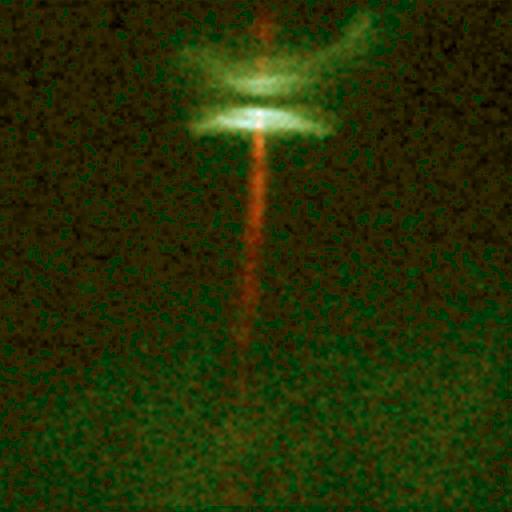 It is within this time frame and beyond that the short-lived Herbig-Haro objects are created, forming from individual stars that begin to develop within the stellar gas and dust clouds, sometimes ejecting matter in the form of jets or protoplanetary disks. At right is one such object in the constellation of Taurus. "This view of a protostellar object called HH-30 reveals an edge-on disk of dust encircling a newly forming star. Light from the forming star illuminates the top and bottom surfaces of the disk, making them visible, while the star itself is hidden behind the densest parts of the disk.The reddish jet emanates from the inner region of the disk, and possibly directly from the star itself. Hubble's detailed view shows, for the first time, that the jet expands for several billion miles from the star, but then stays confined to a narrow beam. The protostar is 450 light-years away in the constellation Taurus." Image of R Corona Australis:
It is within this time frame and beyond that the short-lived Herbig-Haro objects are created, forming from individual stars that begin to develop within the stellar gas and dust clouds, sometimes ejecting matter in the form of jets or protoplanetary disks. At right is one such object in the constellation of Taurus. "This view of a protostellar object called HH-30 reveals an edge-on disk of dust encircling a newly forming star. Light from the forming star illuminates the top and bottom surfaces of the disk, making them visible, while the star itself is hidden behind the densest parts of the disk.The reddish jet emanates from the inner region of the disk, and possibly directly from the star itself. Hubble's detailed view shows, for the first time, that the jet expands for several billion miles from the star, but then stays confined to a narrow beam. The protostar is 450 light-years away in the constellation Taurus." Image of R Corona Australis: 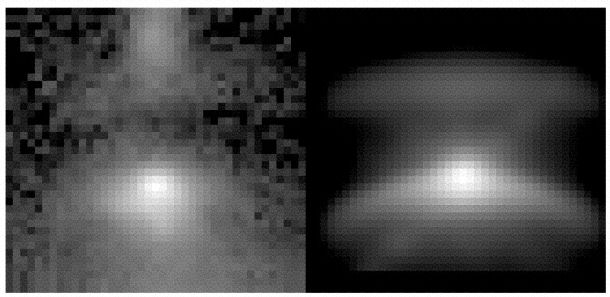 Image (R-band) of Haro 6-5B. This image is one of several obtained by the Wide Field and Planetary Camera 2 Investigation Definition Team's research around the star and nebulosity of FS Tauri A, conducted using the "Hubble Space Telescope (HST) to image circumstellar material around young stellar objects" [9]
Image (R-band) of Haro 6-5B. This image is one of several obtained by the Wide Field and Planetary Camera 2 Investigation Definition Team's research around the star and nebulosity of FS Tauri A, conducted using the "Hubble Space Telescope (HST) to image circumstellar material around young stellar objects" [9]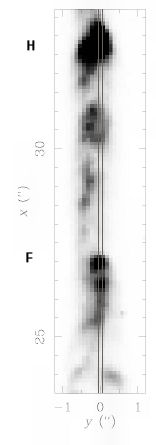
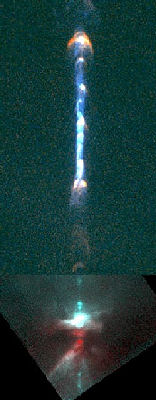 Image far Left: In their paper Kinematics of the HH 111 jet from STIS spectra (
Image far Left: In their paper Kinematics of the HH 111 jet from STIS spectra ( 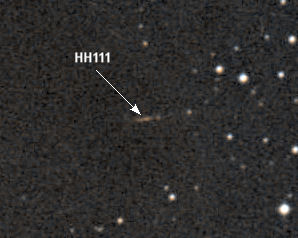
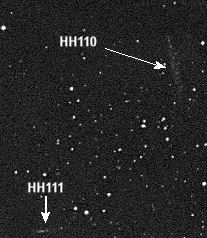 As noted by Bo Reipurth, John Bally and Jon Morse, "The ultimate goal of research on jets is to probe the nature of physical processes that operate within several AU of a young star, to learn about the potential existence of physical conditions that might lead to the formation of planets, and to understand how stars and planetary systems form." [12] This goal was the result of ongoing surveys of
As noted by Bo Reipurth, John Bally and Jon Morse, "The ultimate goal of research on jets is to probe the nature of physical processes that operate within several AU of a young star, to learn about the potential existence of physical conditions that might lead to the formation of planets, and to understand how stars and planetary systems form." [12] This goal was the result of ongoing surveys of  One of the more recent and dramatic images of HH objects appeared on the APOD website on August 11, 2007 and it gives an insight into the turbulent forces within these objects. "Light-years in length, this cosmic tornado is actually a powerful jet cataloged as HH (Herbig-Haro) 49/50 blasting down from the top of a Spitzer Space Telescope view. Though such energetic outflows are well known to be associated with the formation of young stars, the exact cause of the spiraling structures apparent in this case is still mysterious. The embryonic star responsible for the 100-kilometer per second jet is located just off the top of the picture, while the bright star seen near the tip of the jet may just by chance lie along the line of sight. In the false-color infrared image, the tornado glows with infrared light generated as the outflow heats surrounding dust clouds. The color coding shows a trend from red to blue hues at the tornado's tip indicating a systematic increase in emission at shorter wavelengths. The trend is thought to indicate an increase in molecular excitation closer to where the head of the jet is impacting interstellar gas. HH49/50 is about 450 light-years distant, located in the Chamaeleon I molecular cloud." Credit: J. Bally (Univ. of Colorado) et al., JPL-Caltech, NASA, image from
One of the more recent and dramatic images of HH objects appeared on the APOD website on August 11, 2007 and it gives an insight into the turbulent forces within these objects. "Light-years in length, this cosmic tornado is actually a powerful jet cataloged as HH (Herbig-Haro) 49/50 blasting down from the top of a Spitzer Space Telescope view. Though such energetic outflows are well known to be associated with the formation of young stars, the exact cause of the spiraling structures apparent in this case is still mysterious. The embryonic star responsible for the 100-kilometer per second jet is located just off the top of the picture, while the bright star seen near the tip of the jet may just by chance lie along the line of sight. In the false-color infrared image, the tornado glows with infrared light generated as the outflow heats surrounding dust clouds. The color coding shows a trend from red to blue hues at the tornado's tip indicating a systematic increase in emission at shorter wavelengths. The trend is thought to indicate an increase in molecular excitation closer to where the head of the jet is impacting interstellar gas. HH49/50 is about 450 light-years distant, located in the Chamaeleon I molecular cloud." Credit: J. Bally (Univ. of Colorado) et al., JPL-Caltech, NASA, image from 
 Two opposite jets ram into the surrounding interstellar matter forming HH34, another object with some very distinct characteristics and unknowns. "Some features of HH-34 are understood -- some are not. At the core of Herbig-Haro 34 lies a seemingly typical young star. This star, though, somehow ejects energetic "bullets" of high-energy particles, appearing as red streaks toward the lower right of the this image. Astronomers speculate that a burst of these particles might rebound when gas from a disk surrounding the star momentarily collapses onto the star. Visible near the end of each light-year long jet is a glowing cap. HH-34 lies about 1500 light-years away in the Orion Nebula star-forming region. The cause of the large arc of gas on the upper left known as the waterfall remains unexplained." Image from
Two opposite jets ram into the surrounding interstellar matter forming HH34, another object with some very distinct characteristics and unknowns. "Some features of HH-34 are understood -- some are not. At the core of Herbig-Haro 34 lies a seemingly typical young star. This star, though, somehow ejects energetic "bullets" of high-energy particles, appearing as red streaks toward the lower right of the this image. Astronomers speculate that a burst of these particles might rebound when gas from a disk surrounding the star momentarily collapses onto the star. Visible near the end of each light-year long jet is a glowing cap. HH-34 lies about 1500 light-years away in the Orion Nebula star-forming region. The cause of the large arc of gas on the upper left known as the waterfall remains unexplained." Image from 
 "As the collimated protostellar jet interacts with the undisturbed ambient medium, it generates what is known as a "working surface" that the observer then sees as an HH object. The most violent interaction occurs at the initial point of contact between the jet and the ambient medium resulting in a terminal working surface, which is often bow-shaped (for example HH 34S shown [left]). Internal working surfaces trace milder internal collisions within the outflow itself. Each HH object or knot represents a major event of mass ejection and it is therefore likely that these internal shocks occur when fast moving gas from a fresh ejection episode catches up with slower moving material ejected earlier. Hence the archetypal HH jet mentioned above is traced by a series of knots. This is the exact morphology of the HH 34 jet as imaged in [SII] [not shown]. Indeed several of the knots in this flow appear to be bow-shaped, consistent with the idea that they are internal working surfaces." The image at left is a close-up from the larger image, Protostar HH-34 in Orion from the
"As the collimated protostellar jet interacts with the undisturbed ambient medium, it generates what is known as a "working surface" that the observer then sees as an HH object. The most violent interaction occurs at the initial point of contact between the jet and the ambient medium resulting in a terminal working surface, which is often bow-shaped (for example HH 34S shown [left]). Internal working surfaces trace milder internal collisions within the outflow itself. Each HH object or knot represents a major event of mass ejection and it is therefore likely that these internal shocks occur when fast moving gas from a fresh ejection episode catches up with slower moving material ejected earlier. Hence the archetypal HH jet mentioned above is traced by a series of knots. This is the exact morphology of the HH 34 jet as imaged in [SII] [not shown]. Indeed several of the knots in this flow appear to be bow-shaped, consistent with the idea that they are internal working surfaces." The image at left is a close-up from the larger image, Protostar HH-34 in Orion from the  HST images of HH 34S and the proper motions derived by Reipurth et al. (2002). The x-axis approximately coincides with the outflow axis. We have chosen 5 of the cross-correlation boxes of Reipurth et al. (2002), which lie along the edge of the bowshock and which include filamentary structures with well defined orientations (the boxes are numbered 6, 13, 18, 19, and 21). [14]
HST images of HH 34S and the proper motions derived by Reipurth et al. (2002). The x-axis approximately coincides with the outflow axis. We have chosen 5 of the cross-correlation boxes of Reipurth et al. (2002), which lie along the edge of the bowshock and which include filamentary structures with well defined orientations (the boxes are numbered 6, 13, 18, 19, and 21). [14]
 At left is a six-year time-laspe movie created from images taken of HH30. Writes the
At left is a six-year time-laspe movie created from images taken of HH30. Writes the  At left is an image from the
At left is an image from the  This particular region contains a wealth of other stellar objects within a 10 arcminute radius of HH30 that includes: Herbig-Haro objects 150, 151, 152, 153, 154, 265A, B & C, 454A, B & C, Lynds Dark Nebula LDN 1551, the variable stars Bad 17, 18 & 19 and the molecular cloud MBM 109 ( just off the lower right of image ), to mention just a few of the 252 objects returned from the SIMBAD data query site. [15] Image at right: "This Wide Field and Planetary Camera 2 (WFPC2) image shows Herbig-Haro 30 (HH 30) the prototype of a young star surrounded by a thin, dark disk and emitting powerful gaseous jets. The disk extends 40 billion miles from left to right in the image, dividing the nebula in two. The central star is hidden from direct view, but its light reflects off the upper and lower surfaces of the disk to produce the pair of reddish nebulae. The gas jets are shown in green." Credit: Chris Burrows (STScI), the WFPC2 Science Team and NASA, from the
This particular region contains a wealth of other stellar objects within a 10 arcminute radius of HH30 that includes: Herbig-Haro objects 150, 151, 152, 153, 154, 265A, B & C, 454A, B & C, Lynds Dark Nebula LDN 1551, the variable stars Bad 17, 18 & 19 and the molecular cloud MBM 109 ( just off the lower right of image ), to mention just a few of the 252 objects returned from the SIMBAD data query site. [15] Image at right: "This Wide Field and Planetary Camera 2 (WFPC2) image shows Herbig-Haro 30 (HH 30) the prototype of a young star surrounded by a thin, dark disk and emitting powerful gaseous jets. The disk extends 40 billion miles from left to right in the image, dividing the nebula in two. The central star is hidden from direct view, but its light reflects off the upper and lower surfaces of the disk to produce the pair of reddish nebulae. The gas jets are shown in green." Credit: Chris Burrows (STScI), the WFPC2 Science Team and NASA, from the 
 One of the benefits of Herbig-Haro objects stems from their very fast jets and, in stellar terms, their relatively short life spans. Since 1995, several HH objects have had their complex structures and variable speeds well demonstrated in a series of movies composed of the still images taken over the intervening years. To the left is Herbig-Haro 1 and at right, the bow shock of Herbig-Haro 47.
One of the benefits of Herbig-Haro objects stems from their very fast jets and, in stellar terms, their relatively short life spans. Since 1995, several HH objects have had their complex structures and variable speeds well demonstrated in a series of movies composed of the still images taken over the intervening years. To the left is Herbig-Haro 1 and at right, the bow shock of Herbig-Haro 47. Image of Herbig-Haro 1 and 2 from the
Image of Herbig-Haro 1 and 2 from the